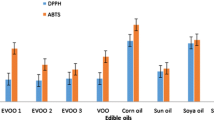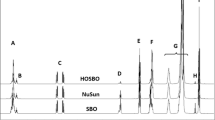Abstract
Within the course of lipid peroxidation, hydroperoxides are formed as primary products. They can be used as analytical markers to assess the deterioration status of oils and fats. Here a new 1H-NMR assay to determine the hydroperoxide amount in edible oils is presented. We were able to show that the analytical performance of the method is similar to that of the commonly used peroxide value (PV) according to Wheeler. A total of 290 edible oil samples were analyzed using both methods. For some oil varieties considerable discrepancies were found between the results obtained. In the case of black seed and olive oil, two substances could be identified that cause positive (black seed oil) and negative (olive oils) deviations from the theoretical PV expected from the NMR values.








Similar content being viewed by others
References
(2011) European Pharmacopoeia 7th edition. European department for the quality of medicines, Strasbourg http://www.pheur.eu
United States Pharmacopoeia (USP) 34 (2010) The United States pharmacopoeia convention. Rockville, MD
Frankel EN (1980) Lipid oxidation. Prog Lipid Res 19:1–22
Firestone D (ed) (2009) Official methods and recommended practices of the AOCS, 6th edn. AOCS Press Champaign, Method Cd 8b-90
(2010) DIN EN ISO 3960, Animal and vegetable fats and oils—determination of peroxide value—iodometric (visual) endpoint determination (ISO 3960:2007, corrected version 2009-05-15); German version EN ISO 3960:2010
Kamal-Eldin A, Pocorny J (2005) Analysis of lipid oxidation. AOCS Press, Champaign
Yildiz G, Wehling RL, Cuppett SL (2003) Comparison of four analytical methods for the determination of peroxide value in oxidized soybean oils. JAOCS 80:103–107
Saito H (1987) Estimation of the oxidative determination of fish oils by measurement of nuclear magnetic resonance. Agric Biol Chem 51:3433–3435
Shahidi F, Wanasundara UN (1997) Application of proton nuclear magnetic resonance (1H NMR) spectroscopy for assessment of oxidative stability of fats and oils. In: Shahidi F (ed) Natural antioxidants—chemistry, health effects, and applications. AOCS Press, Champaign
Abou-Gharbia HA, Shahidi F, Shehata AA, Youssef MM (1997) Effects of processing on oxidative stability of sesame oil extracted from intact and dehulled seeds. JAOCS 74:215–221
Porter NA, Mills KA, Carter RL (1994) A mechanistic study of oleate autoxidation—competing peroxyl H-atom abstraction and rearrangement. J Am Chem Soc 116:6690–6696
Hämäläinen TI, Sundberg S, Mäkinen M, Kaltia S, Hase T, Hopia A (2001) Hydroperoxide formation during autoxidation of conjugated linoleic acid methyl ester. Eur J Lipid Sci Technol 103:588–593
Pajunen TI, Koskela H, Hase T, Hopia A (2008) NMR properties of conjugated linoleic acid (CLA) methyl ester hydroperoxides. Chem Phys Lipids 154:105–114
Brash AR (2000) Autoxidation of methyl linoleate: identification of the bis-allylic 11-hydroperoxide. Lipids 35:947–952
Tokita M, Morita M (2000) Identification of new geometric isomers of methyl linoleate hydroperoxide and their chromatographic behavior. Biosci Biotechnol Biochem 64:1044–1046
Falch E, Anthonsen HW, Axelson DE, Aursand M (2004) Correlation between 1H NMR and traditional methods for determining lipid oxidation of ethyl docosahexaenoate. JAOCS 81:1105–1110
Frankel EN, Neff WE, Miyashita K (1990) Autoxidation of polyunsaturated triacylglycerols II. Trilinolenoylglycerol. Lipids 25:40–47
Neff WE, Frankel EN, Miyashita K (1990) Autoxidation of Polyunsaturated triacylglycerols: I. Trilinoleoylglycerol. Lipids 25:33–39
Silwood CJL, Grootveld M (1999) Application of high-resolution, two-dimensional 1H and 13C nuclear magnetic resonance techniques to the characterization of lipid oxidation products in autoxidized linoleoyl/linolenoylglycerols. Lipids 34:741–756
Claxson AWD, Hawkes GE, Richardson DP, Naughton DP, Haywood RM, Chander CL, Atherton M, Lynch EJ, Grootveld MC (1994) Generation of lipid peroxidation products in culinary oils and fats during episodes of thermal stressing: a high field 1H NMR study. FEBS Lett 355:81–90
Holzgrabe H (2010) Quantitative NMR Spectroscopy in Pharmaceutical Applications. Prog Nucl Mag Res Sp 57:229–240
Beyer T, Diehl B, Holzgrabe U (2010) Quantitative NMR spectroscopy of biologically active substances and excipients. Bioanal Rev 2:1–22
Guillen MD, Goicoechea E (2009) Oxidation of corn oil at room temperature: primary and secondary oxidation products and determination of their concentration in the oil liquid matrix from 1H nuclear magnetic resonance data. Food Chem 116:183–192
Draper NR, Smith H (1998) Applied regression analysis, 3rd edn. Wiley, New York
Mandel J (1964) The statistical analysis of experimental data. Wiley, New York
Miyake Y, Yokomizo K, Matsuzaki N (1998) Rapid determination of iodine value by 1H nuclear magnetic resonance spectroscopy. JAOCS 75:15–19
Fribolin H (2006) Ein-und zweidimensionale NMR-Spektroskopie: Eine Einführung, Wiley-VCH, Weinheim
Günther H (1996) NMR Spectroscopy, 2nd edn. Wiley, Chichester
Chan HWS, Levett G (1976) Autoxidation of methyl linoleate. separation and analysis of isomeric mixtures of methyl linoleate hydroperoxides and methyl hydroxylinoleates. Lipids 12:99–104
Frankel EN (1991) Review recent advances in lipid oxidation. J Sci Food Agric 54:495–511
Danzer K, Currie LA (1998) Guidelines for calibration in analytical chemistry. Pure Appl Chem 70:993–1014
Hubaux A, Vos G (1970) Decision and detection limits for linear calibration curves. Anal Chem 42:849–855
EURACHEM/CITAC guide—quantifying uncertainty in analytical measurement (2000), second edition
Burits M, Bucar F (2000) Antioxidant activity of Nigella sativa essential oil. Phytother Res 14:323–328
Sharma NK, Ahirwar D, Jhade D, Gupta S (2009) Medicinal and pharmacological potential of Nigella sativa: a review. Ethnobot Rev 13:946–955
Butt MS, Sultan MT (2010) Nigella sativa: reduces the risk of various maladies. Crit Rev Food Sci Nutr 50:654–665
Soler-Rivas C, Espin JC, Wichers HJ (2000) Review oleuropein and related compounds. J Sci Food Agric 80:1013–1023
Vissers MN, Zock PL, Katan MB (2004) Bioavailability and antioxidant effects of olive oil phenols in humans: a review. EJCN 58:955–965
Servili M, Montedoro G (2002) Contribution of phenolic compounds to virgin olive oil quality. Eur J Lipid Sci Technol 104:602–613
Conflict of interest
There is no conflict of interest.
Author information
Authors and Affiliations
Corresponding author
Appendix: Deming Regression and Relative Sensitivity
Appendix: Deming Regression and Relative Sensitivity
Assume that the relationship between the peroxide value according to Wheeler, y, and the true but unknown hydroperoxide amount z is given by a linear model of the form
y(z) denotes the conditional expectation of y and η represents the random error. η is supposed to follow a normal distribution with mean zero and constant variance \( \sigma_{\eta }^{2} \). g and d are the model parameters. Analogously, we assume that the NMR-determined peroxide amount x is related to z by the equation
where \( X(z) = k + lz \) is the conditional expectation of x and the term ε designates the error. ε is supposed to be normally distributed with mean zero and constant variance \( \sigma_{\varepsilon }^{2} \). For the time being, let us assume that all parameters and variances are known. Then, applying the Gaussian law of uncertainty propagation, it follows that for a given y 0 the standard deviation of the estimate \( \hat{z}(y_{0} ) = (y_{0} - d)/g \) is
In the same way, we obtain for the standard deviation of the estimate \( \hat{z}(x_{0} ) = (x_{0} - k)/l \, : \)
The relative sensitivity [25] of the NMR assay with respect to the Wheeler method, RSNMR/Wheeler, is defined as
If RSNMR/Wheeler appreciably exceeds unity, the NMR approach would have the greater ability to detect a difference in the actual hydroperoxide amount z. The opposite conclusion holds when RSNMR/Wheeler is clearly smaller than unity. How can we estimate RSNMR/Wheeler? To answer this question, the Eq. (2) and (3) have to be considered. Solving the Eq. (3) for z and inserting the result into (2) gives us
By substituting a for \( - \frac{g}{l}k + d \) and b for \( \frac{g}{l} \), we obtain
or
with \( x = X + \varepsilon \) and \( y = Y + \eta \). Equation (9) connects the peroxide value y to the NMR-determined peroxide amount x and represents a so-called Deming regression model. Minimizing the sum
for a given data set \( (x_{i} , \, y_{i} )_{i = 1, \ldots ,n} \) with respect to a, b and X yields the maximum likelihood estimators for \( \hat{a} \), \( \hat{b} \) and \( \hat{X} \):
where \( {\text{SS}}_{yy} = \sum {(y_{i} - \bar{y}_{i} )^{2} } \), \( {\text{SS}}_{xx} = \sum {(x_{i} - \bar{x}_{i} )^{2} } \) and \( {\text{SS}}_{xy} = \sum {(x_{i} - \bar{x}_{i} )(y_{i} - \bar{y}_{i} )} . \)
With \( \frac{g}{l} = b \), we can rewrite Eq. (6) as
To compute \( \hat{b} \) and to estimate the relative sensitivity, an estimate for \( \sigma_{\varepsilon } /\sigma_{\eta } \) is needed. The latter can be obtained as follows: Firstly, n different mixtures of a peroxide-free and a peroxide-containing oil are prepared with mixing ratios \( v_{i = 1, \ldots ,n} \). Analyzing these samples by both methods provides the x i and y i . Then, we regress x i on \( \nu_{i} \) and y i on \( \nu_{i} \) by simple linear least-squares fitting and calculate the corresponding residual standard deviations rsd νx and rsd νy. Since \( \nu \propto z \), \( \sigma_{\varepsilon } \) can be estimated as
and \( \sigma_{\eta } \) as
About this article
Cite this article
Skiera, C., Steliopoulos, P., Kuballa, T. et al. 1H-NMR Spectroscopy as a New Tool in the Assessment of the Oxidative State in Edible Oils. J Am Oil Chem Soc 89, 1383–1391 (2012). https://doi.org/10.1007/s11746-012-2051-9
Received:
Revised:
Accepted:
Published:
Issue Date:
DOI: https://doi.org/10.1007/s11746-012-2051-9




